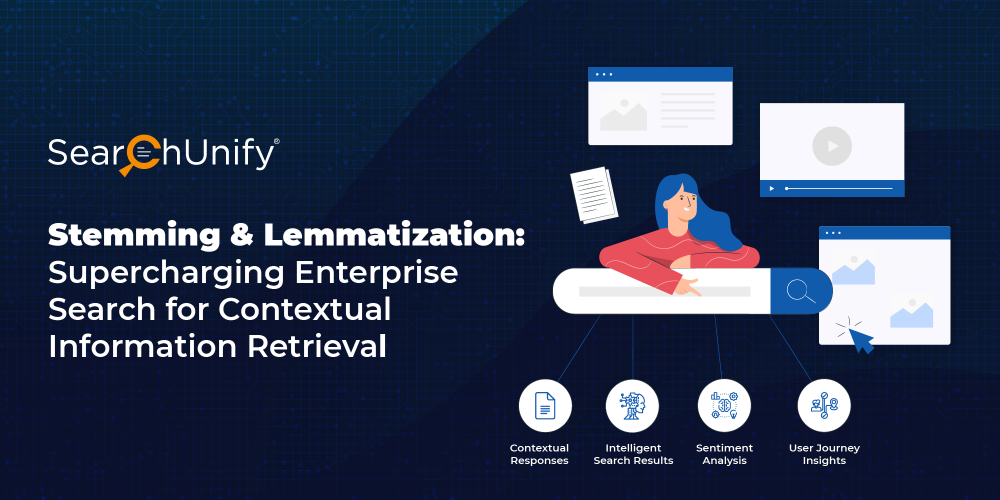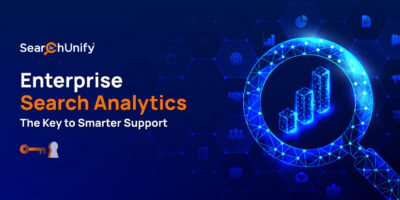
“Gartner suggests that NLP and conversational analytics will boost analytics and business intelligence adoption from 35% of employees to over 50% by 2021.”
Natural language processing (NLP) is a fast-emerging technology, and every organization is in a race to get the most out of it. From intelligent chatbots to voice assistants, we have witnessed organizations all around the world embark on the AI journey in several ways.
A few decades back, the possibility of communication between a human and technology seemed like a dream. But NLP has changed that and is ready to become an indispensable part of organizations. So much so that a report estimates the global NLP market size to shoot up from USD 11.6 billion in 2020 to USD 35.1 billion by 2026.
One of the ways to harness NLP is through cognitive search, which is the more advanced form of enterprise search. Cognitive search is revolutionizing the process of enriching, retrieving, and analyzing information from a cornucopia of data by being a single point-of-access to enterprise content sources. But what a conundrum it would be if the algorithms behind cognitive search cannot decode the similarities between the words like ‘ticket’, ‘tickets,’ and ‘ticketing’. This would create findability havoc, right?
This is where stemming and lemmatization come to the rescue. A cognitive search employs NLP-fueled stemming and lemmatization to inject relevancy in the search results after indexing multiple data sources. It catapults many business functions. But before we explore their every nook and cranny, let’s understand what stemming and lemmatization mean.
Stemming & Lemmatization – Truncating a Word to Its Base Unit With & Without Context
Stemming and lemmatization are text normalization techniques that are applied to process text, words, and documents to extricate high-quality information.
Stemming is somewhat a make-do method for cataloging related words. It is the process of decoding the variations of words from their word stem. For instance, when you search ‘network’, you may also get the results for ‘networks’ and ‘networking’. Here, your word stem is ‘network’. The challenge arises when words like ‘embodies’ are searched and the stemming algorithm chops off the word into ‘embodi’. This is where lemmatization comes into play.
Lemmatization is a more calculated process in which the words are resolved into their dictionary or canonical form. Lemmatization algorithms understand the context of every word and display the best possible results. For instance, if you search ‘imperfect’ or ‘better’, you may get results for ‘not perfect’ or ‘good.’ Impressive, right? Now, let’s dig deeper to know the difference between stemming and lemmatization.
Difference Between Stemming & Lemmatization
| Stemming | Lemmatization | |
|---|---|---|
| 1 | Stemming can be done very quickly as it simply chops words from their word stem without understanding the actual context. | Lemmatization is comparatively slower as it emphasizes understanding the context of a word as per its dictionary meaning. |
| 2 | It is a rule-based approach. | It is a dictionary-based approach. |
| 3 | It is simpler: but in many cases, it has low accuracy. | It is relatively complex as deep linguistics knowledge is used to derive dictionary meaning, but the results are more accurate. |
| 4 | It is used majorly when the context of the word is not important for analysis. Example: Spam Detection | It is used majorly when the contextual meaning of words is crucial for analysis. Example: Question Answer |
| 5 | For Example: “Embodies” => “Embodi” “Easily” => “Easi” | For Example: “Embodies” => “Embody” “Better” => “Good” |
How Stemming & Lemmatization Catapult Various Enterprise Functions
1. Intelligent Search Results
For the uninitiated, Forrester defines cognitive search as “the new generation of enterprise search that employs AI technologies such as natural language processing and machine learning to ingest, understand, organize, and query digital content from multiple data sources.”
If you want your enterprise’s search engine to return relevant results from your data corpus, it must understand the intent of the search query. Cognitive search uses NLP-driven stemming and lemmatization to extract intent and pump in relevancy into search results. For example, if a user searches for ‘Salesforce,’ cognitive search will index documents related to the particular tech, rather than breaking the word and presenting ‘Sales’ related results as well.
2. Sentiment Analysis & Prioritization
Another business application powered by stemming and lemmatization is sentiment analysis. They’re already revolutionizing the customer support area. This is used by enterprises to analyze available support ticket data and detect customer sentiments and emotional tone for incoming cases in real-time. This allows agents to empathize and personalize accordingly. Sounds complex?
Apps like Escalation Predictor make it easy. It automatically detects positive and negative sentiment within your support data. Then, it identifies and prioritizes support tickets that have a higher chance of escalating. This way, you can assign the best agent to every ticket right away and keep escalations at bay!
3. Generate Accurate User Journey Insights
Apart from better search results and sentiment analysis, stemming and lemmatization algorithms are used to analyze customer data to truly understand their needs, identify their lifestyles, and predict the best action in a matter of seconds based on the search history and engagement patterns.
You don’t have to start from scratch or be a technical expert to leverage these benefits. Apps like Agent Helper analyze and learn from historical data and suggest helpful content related to customer journey insights to your agents. Pretty slick, right?
4. Crafting Contextual Responses
NLP is ubiquitous, and service organizations benefit from it heavily. Stemming and lemmatization power apps that can analyze conversations in the online community threads to extract context & accordingly tag them with relevant topics and categories.
Community Helper is one such app. In addition to relevant tagging on online communities, it understands queries and scours the unified index to deliver contextual responses on unanswered threads, especially at odd hours.
Want to Leverage NLP for Your Enterprise? This Guide Can Help
It is imperative for business leaders to understand what NLP brings to the table and explore its business applications – especially for the customer service vertical. Then, successfully integrate it with their ecosystems and reap its benefits. This free e-book is the complete guide for elevating business outcomes with NLP. Download it and start your NLP journey today!











